| Pages:
1
2
3
4
5
6
..
9 |
blogfast25
International Hazard
    
Posts: 10562
Registered: 3-2-2008
Location: Neverland
Member Is Offline
Mood: No Mood
|
|
Thorium hydroxide, you don't see that everyday.
Looks like you're inching forward. Stay safe!
|
|
|
sbreheny
Hazard to Others
  
Posts: 145
Registered: 30-1-2014
Member Is Offline
Mood: No Mood
|
|
Dan - I hope that you have some radiation measuring equipment and that you are taking precautions. 227g of Thorium Nitrate is going to be emitting
quite a bit of radiation. I have a 10g sample which, if I recall correctly, registers about 10mR/hr on my Geiger counter at a few inches away. I know
that this is probably way off because of the lack of proper calibration, etc., but it's enough that I wouldn't want to spend much time around it (30
hours would be 1 year's worth of natural background radiation). Much worse would be if you were to inhale even a tiny amount of dust or droplets of
solution. Sean
|
|
|
Dan Vizine
National Hazard
   
Posts: 628
Registered: 4-4-2014
Location: Tonawanda, New York
Member Is Offline
Mood: High Resistance
|
|
This thorium hydroxide (or hydrated thorium dioxide) is an absolutely wretched material. The washings took four days to complete, filtration was very
slow and difficult. This will dry to a fairly voluminous solid. My only hope of using my original reaction vessel for the reduction is if calcining
densifies it.
The solid is still in the funnel mainly because I haven't decided on the best way to air dry it yet. This outcome was pretty much the next to worst
case scenario, only a gel could have been worse.
In the meantime, I built another "disposable" furnace for calcining. The picture is of the first run to 1200 C (just to see if it could).
I'm trying to use disposables as much as possible. The filter funnel is a 1000 cc Nalgene HDPE bottle fitted with a porous polyethylene filter disk
about 1/2 thick.
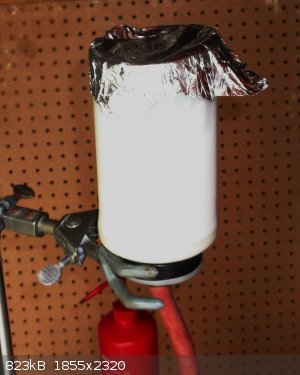 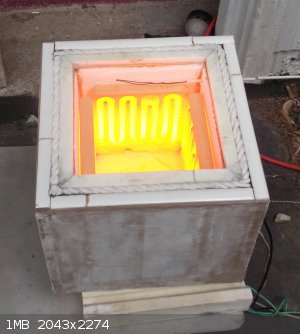
|
|
|
careysub
International Hazard
    
Posts: 1339
Registered: 4-8-2014
Location: Coastal Sage Scrub Biome
Member Is Offline
Mood: Lowest quantum state
|
|
Quote: Originally posted by sbreheny  | | ... I have a 10g sample which, if I recall correctly, registers about 10mR/hr on my Geiger counter at a few inches away. I know that this is probably
way off because of the lack of proper calibration, etc., but it's enough that I wouldn't want to spend much time around it |
But only for the part of your body that was a few inches away from it. Don't tape it to your pillow.
| Quote: | | (30 hours would be 1 year's worth of natural background radiation) |
Or 120 hours if you live in Denver (they seem to be doing okay, despite getting 800-900 mRem more than the 'average').
|
|
|
Dan Vizine
National Hazard
   
Posts: 628
Registered: 4-4-2014
Location: Tonawanda, New York
Member Is Offline
Mood: High Resistance
|
|
Quote: Originally posted by sbreheny  | Dan - I hope that you have some radiation measuring equipment and that you are taking precautions. 227g of Thorium Nitrate is going to be emitting
quite a bit of radiation. I have a 10g sample which, if I recall correctly, registers about 10mR/hr on my Geiger counter at a few inches away. I know
that this is probably way off because of the lack of proper calibration, etc., but it's enough that I wouldn't want to spend much time around it (30
hours would be 1 year's worth of natural background radiation). Much worse would be if you were to inhale even a tiny amount of dust or droplets of
solution. Sean
|
Sean, The relative hazards of this have been considered for months. Every reasonable step is taken to avoid contamination.
I even let the radiation angle dictate the chemistry. The "hydroxide" step was only done to get rid of the most important contaminant, radium. I could
have calcined the nitrate directly. The aqueous nitrate was sparged with air for an hour (outside) just to be rid of radon.
I've spent quite some reading about the long term dangers of trace thorium dioxide ingestion/inhalation and I've concluded that I can live with the
dangers.
Is anybody else surprised that a pound was sent to me and it was not specially wrapped. Nevertheless, it didn't, apparently, set off any radiation
detectors anywhere.
|
|
|
Dan Vizine
National Hazard
   
Posts: 628
Registered: 4-4-2014
Location: Tonawanda, New York
Member Is Offline
Mood: High Resistance
|
|
Well, at least you catch a break now and again. The extremely bulky bright white solid has dried down to a dense, friable off-white solid of only 15 -
20% of the original volume. Tomorrow I'll finish drying to constant weight at 80 - 90 degrees C.
The process tube and the reactor will still be suitable.
Hopefully, calcination, grinding & sieving (in a glovebag) will be done early next week.
|
|
|
careysub
International Hazard
    
Posts: 1339
Registered: 4-8-2014
Location: Coastal Sage Scrub Biome
Member Is Offline
Mood: Lowest quantum state
|
|
Source of Thorium
Today it appears the cheapest (and quite readily available) source is 2% thoriated tungsten welding rods, at a thorium cost of $10/g.
Lots of Alibaba offers though for thorium nitrate, some in ridiculous quantities (minimum order one metric ton), but the price is $10/kg. Other offers
sell in gram amounts with a listed price range of $1-$100 per gram (one gram minimum). I wonder how much you would have to buy to get the $1/gram
price.
I shudder to think about the importation issues of a kilogram of thorium these days.
|
|
|
Dan Vizine
National Hazard
   
Posts: 628
Registered: 4-4-2014
Location: Tonawanda, New York
Member Is Offline
Mood: High Resistance
|
|
The import difficulties are so great that one website selling elements had a buy lined up from GB, but had to scuttle the whole thing just because of
these issues.
I've never seen anyone who claimed to have actually gotten the thorium out of thoriated tungsten.
There is a world of difference between "so-and-so sells thorium" and "I can buy thorium". Almost as big as "it's in there, and I want to get it out."
This is the easiest way to get it that I see (well, it could have been easier if I had been able to buy ThO2).
[Edited on 21-8-2014 by Dan Vizine]
|
|
|
careysub
International Hazard
    
Posts: 1339
Registered: 4-8-2014
Location: Coastal Sage Scrub Biome
Member Is Offline
Mood: Lowest quantum state
|
|
I see some on this thread:
http://www.sciencemadness.org/talk/viewthread.php?tid=395
The H2O2 dissolution of tungsten seems to work rather well. The only question was whether the small amount of insoluble residue was pure thorium, or
had some tungsten phosphate.
I think dissolving the residue in hot conc H2SO4 to make soluble thorium sulfate (tungsten resists sulfuric attack) would eliminate any possible
tungsten admixture.
[Edited on 22-8-2014 by careysub]
|
|
|
Dan Vizine
National Hazard
   
Posts: 628
Registered: 4-4-2014
Location: Tonawanda, New York
Member Is Offline
Mood: High Resistance
|
|
But then you are left with thorium sulfate, not the metal. And if you want the metal you need to do further processing. In my view, it's just better
to start with reagent grade materials than stack successive steps, each with its own handling peculiarities (and then you have to face the expanded
decontamination of additional equipment).
If I could have started with ThO2, I would have.
After drying at 90 degrees C for a total of 15 h and pulverizing, 127 g (103 %, TY= 103 g) of a very heavy white powder was obtained. Most likely
residual water. On the plus side, any of the conceivable impurities, water, ammonium nitrate, residual thorium nitrate, all pyrolyze to gasses and/or
ThO2.
Hope to calcine Monday.
|
|
|
blogfast25
International Hazard
    
Posts: 10562
Registered: 3-2-2008
Location: Neverland
Member Is Offline
Mood: No Mood
|
|
I see a plan coming together.
|
|
|
careysub
International Hazard
    
Posts: 1339
Registered: 4-8-2014
Location: Coastal Sage Scrub Biome
Member Is Offline
Mood: Lowest quantum state
|
|
Quote: Originally posted by Dan Vizine  | | But then you are left with thorium sulfate, not the metal. And if you want the metal you need to do further processing. In my view, it's just better
to start with reagent grade materials than stack successive steps, each with its own handling peculiarities (and then you have to face the expanded
decontamination of additional equipment). |
The remark about making the sulfate was only in the case that an insoluble tungsten compound actually is present, as postulated in the old thread (it
does not clarify if their really was excess material on careful weighing). It was proposed on the thread that the contaminant (if it exists) might be
tungsten phosphate.
I just checked and tungsten phosphates are soluble, so I suspect the peroxide dissolution gives a decent grade of thorium oxide directly. This makes
it easier to obtain from this route than preparing it from thorium nitrate (say).
|
|
|
careysub
International Hazard
    
Posts: 1339
Registered: 4-8-2014
Location: Coastal Sage Scrub Biome
Member Is Offline
Mood: Lowest quantum state
|
|
Quote: Originally posted by IrC  | http://www.blackcatmining.com/mining-equipment/mini-sluice.c...
Something like this would provide pounds of black sand with relatively easy work, you set it up on the side of the stream to allow water to run
through it as you shovel in gravel from the stream bed. You remove the carpet from the sluice every so often and wash it inside your 5 gallon paint
bucket half full of water. This way you clean the carpet, the black sand settles to the bottom of the bucket. Put the carpet back in the sluice and
run it again. Eventually you carefully pour the water out of the bucket leaving pounds of black sand in the bottom to take home and process. They have
a page of tutorials: http://www.keeneeng.com/resources.html
Actually a lot of weekend fun as a hobby. I ran a 3.5 inch dredge and recovered about 14 oz Gold in 83 on my weekends. Was a nice way to get fresh
outdoor air and sun to combat stress from the work week....
[Edited on 5-6-2014 by IrC] |
If anyone decides to sally forth and pan (or sluice) for monazite sand, I am sure they could pick up some cash selling it on eBay, or here (less
scrutiny here).
Radioactive minerals go for significant coin on eBay; I don't see anyone on-line anywhere selling it.
Here is an interesting report describing the Carolina deposits:
https://archive.org/stream/monazitethoriumm00kithiala/monazi...
Here is a choice bit:
| Quote: |
The content of monazite
in the concentrated black sands, however, is small compared with that
of the sluicing concentrates of other sections. The monazite in this
section after being purified seldom shows a higher content than 3.5 to
3.75 per cent ThO 2 . There is considerable magnetite in these sands,
and the bulk of the concentrates consists of ilmenite (titaniferous iron) .
|
Currently thorium salts (at their cheapest) are going for $10/g. Using that market benchmark, a kilogram of monazite sand concentrate might contain
$350 worth of thorium. This is also ten times higher than the concentration of thorium in good ore in the Lemhi Pass formation.
I wonder if a rack of magnets would pull this sand in.
[Edited on 23-8-2014 by careysub]
[Edited on 23-8-2014 by careysub]
|
|
|
Dan Vizine
National Hazard
   
Posts: 628
Registered: 4-4-2014
Location: Tonawanda, New York
Member Is Offline
Mood: High Resistance
|
|
I think that the purity of your material would be highly suspect. I've just inspected a half dozen thoriated tungsten rod MSDS sheets. The % amounts
are given to the nearest per cent. No claims of overall purity are made, so what are you starting with really? You only know to the extent they tell
you, which isn't much. In fact, most of the brands I looked at actually contained thoria, not thorium. The thorium from this method will beat what
you'll get by dissolving welding rods, purity-wise, hands down.
Why not give it a try and we can compare final products by ductility and oxidation resistance?
|
|
|
Dan Vizine
National Hazard
   
Posts: 628
Registered: 4-4-2014
Location: Tonawanda, New York
Member Is Offline
Mood: High Resistance
|
|
Re: Earlier % yield
It should have said "After drying at 90 degrees C for a total of 15 h and pulverizing, 127 g (103 %, TY= 123 g)...."
Calcining is underway @ 1000 C. Expected yield = 411 mmol = 108.5g
At about 400 C, a small amount of brown gas was seen, suggesting a small amount of ammonium nitrate was present. The color disappeared after 10
minutes and water vapor was evolved.
Calcining will proceed for 12 hours.
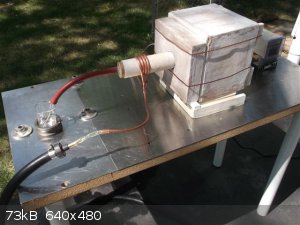
|
|
|
Dan Vizine
National Hazard
   
Posts: 628
Registered: 4-4-2014
Location: Tonawanda, New York
Member Is Offline
Mood: High Resistance
|
|
After a total of 12 hours at 1000 C, the material was recovered from the process tube and finely ground with a mortar and pestle. The resulting
off-white, heavy powder was packaged under argon in a 120 mL bottle to give 108 g (99.5%, T.Y. = 108.5 g)of anhydrous thorium dioxide.
The reduction in volume of the hydrated material was dramatic during calcining to the anhydrous dioxide.
A view down inside the process tube toward end of calcining process and the final intermediate:
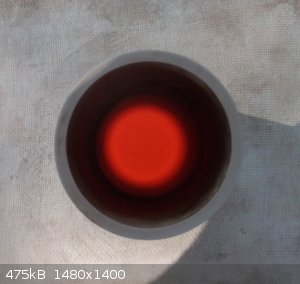 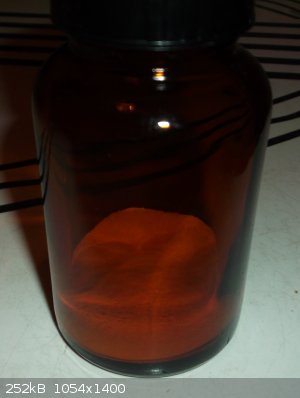
[Edited on 1-9-2014 by Dan Vizine]
|
|
|
careysub
International Hazard
    
Posts: 1339
Registered: 4-8-2014
Location: Coastal Sage Scrub Biome
Member Is Offline
Mood: Lowest quantum state
|
|
Quote: Originally posted by Dan Vizine  | ...
Since I'm talking about thorium dioxide, those of you who have explored these same dark synthetic passageways probably already realize that I have
opted for the straight calcium reduction route for 1 h @ 950 degrees Celsius.
... |
You might be able to do this on a small scale without using a reduction bomb, using calcium chloride as sort of a solvent (it dissolves the calcium
oxide).
This is briefly described on pp. 6-8 of "Advances in Inorganic Chemistry Volume 31" available on Scribd.
Here is a link to pg. 10 on Google Books that you can scroll up from to get to 6-8:
http://books.google.com/books?id=K5_LSQqeZ_IC&pg=PA10&am...
Since many actinides were never available in 100+ gram amounts (usually kilogram amounts) called for most production-oriented bomb reduction
processes, a method that work on the sub-gram scale was needed, and the CaCl2 fluxed DOR process looks like it works pretty well in a stirred
crucible.
I think this is interesting because it can be tried out with a small sample.
|
|
|
Dan Vizine
National Hazard
   
Posts: 628
Registered: 4-4-2014
Location: Tonawanda, New York
Member Is Offline
Mood: High Resistance
|
|
Hi careysub,
That is exactly the method I have decided on. I'm attracted to this method because of the unusually high solubility of metallic Ca in molten CaCl2. I
hate heterogeneous reactions and the CaCl2 solvent at least makes it somewhat less so. I plan to continuously agitate the reactor during reaction.
The actual reference that I plan to model the reaction on is one published by Fuhrman, N., Holden, R.B. and Whitman, C.I. in the Feb. 1960 J. of the
Electrochemical Soc. on pp 127-131. The submission is entitled "Production of Thorium Powder by Calcium Reduction of Thorium Oxide".
My primary deviation from their method is the use of SS 316 instead of the high-chromium, ferritic SS446. As a result, I may pick up more trace iron
and nickel than they did (typically 11 - 46 ppm Fe). My primary concern is residual dioxide and so washes will be extensive.
In this study, the reduction is essentially complete. Typically they got from 78 - 91% yields as coarse powder suitable for consolidation. The
remaining Th is in the fines separated by decantations. If I can repeat these results I should obtain 74.4 - 86.8 g Th. They typically saw 0.3 - 0.4%
residual oxide. If oxide is kept low enough, arc remelted buttons should have a bright metallic surface.
Today, I'm making a furnace roof which is fitted with a porcelain bushing through which the 1/4" SS pipe passes which will provide the head of argon
pressure to the reaction vessel as well as agitate it.
[Edited on 1-9-2014 by Dan Vizine]
|
|
|
careysub
International Hazard
    
Posts: 1339
Registered: 4-8-2014
Location: Coastal Sage Scrub Biome
Member Is Offline
Mood: Lowest quantum state
|
|
I wonder if on a small enough scale stirring would not be needed.
Studying the technical history of the Manhattan Project I was interested to read about how they always tried new processes out on a gram scale (or
even smaller) before trying 100 g scale reactions (often this out of necessity, first getting only small amounts of pure uranium, then plutonium,
etc.).
The metal oxide and calcium chloride can of course be ground together to make an intimate, fine particle mixture; the problem is the calcium -
GalliumSource has granular calcium metal, not sure how to get it finer.
Perhaps in a small enough sample diffusion will provide enough mixing (also you can afford to use the calcium in excess - of that helps the reaction).
Ozark Technical Ceramics makes magnesia crucibles with volumes from 1 mL to 25 mL in prices from $15.20 to $35.70 (larger ones too).
http://ozarktech.com/otc-product/mgo-crucibles/
A small charged crucible could be fired in one of those nifty quick-and-dirty tube furnaces you showed, flushed with argon, to observe the reaction
with only consuming a small amount of thorium oxide.
|
|
|
Dan Vizine
National Hazard
   
Posts: 628
Registered: 4-4-2014
Location: Tonawanda, New York
Member Is Offline
Mood: High Resistance
|
|
Actually, stirring is apparently not needed, ...well, you decide.....
The authors whose work I'm copying did this work in a stationary, unstirred 5 gallon SS "bucket" with a bolt-on head which was heated by induction. I
really don't know for a fact, but I don't think that the "stirring" induced in molten metals by the induction heating process, operates in this
reaction mixture.
Most of the other DOR (direct oxide reduction) processes, described in the reference you cited and elsewhere, don't seem to use stirring. Some early
attempts used agitation of the reactor but that seems to have been abandoned.
Because of my innate distrust of unstirred reaction mixtures, my reactor will be agitated. I had planned to use an old drive similar to that used on a
Kugelrohr (by Aldrich, anyway, the truck windshield wiper unit) but when I dug it out, I found it isn't functional. Agitation will be periodic and by
hand, unless I come up with another way.
My calcium is 99.9% pure in large shiny dendritic pieces stored in vacuo in glass ampoules. I plan to clamp it in a vise and file it, while the
filings are allowed to drop into a funnel leading to a bottle under continual argon purge. Crude, but I don't know of a better way. It should work
well, fingers crossed.
I do need to decide what crucible will be suitable for arc remelting. Beads will be much more commercially appealing than powder or compacts.
|
|
|
Dan Vizine
National Hazard
   
Posts: 628
Registered: 4-4-2014
Location: Tonawanda, New York
Member Is Offline
Mood: High Resistance
|
|
I ended up making the "stirring bearing", in the furnace roof, from a moderately hard ceramic similar to bisque ware.
I welded the required threaded ends onto a 1/4" SS pipe (~12 in. long) which will serve as the means of agitating the crucible as well as the source
for the head of argon ( ~ 5 in Hg) to be maintained during the reaction. I haven't leak tested these joints yet. I know from past experience that good
looking welds are no guarantee of gas tightness, so here's hoping.
Currently prepping the CaCl2 and Ca for the reaction.
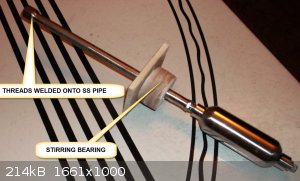 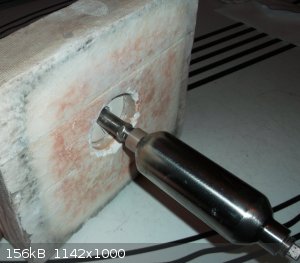
[Edited on 3-9-2014 by Dan Vizine]
|
|
|
Dan Vizine
National Hazard
   
Posts: 628
Registered: 4-4-2014
Location: Tonawanda, New York
Member Is Offline
Mood: High Resistance
|
|
Another detail to address is the final filtration. In keeping with the idea of using disposables whenever possible, I need a set-up which will have a
provision for blanketing the final, potentially pyrophoric thorium powder with argon, following filtration, until it can be transferred into a vessel
connected to vacuum. The blanketing gas should also be supplied in such a way that it can't fail because of positional variations. It also shouldn't
blow in such a way as to potentially kick up any of the finest particles.
I previously mentioned, but didn't explain, my method of funnel construction. I used the material pictured as flat sheets (below) to construct the
desired apparatus. It's sintered polyethylene and it's porous. I cut slightly tapered disks of the thicker material (for unsupported applications) to
be tightly press-fitted into various cut down HDPE bottles (picture 1) which are fitted with a vacuum-tight hose barb (picture 2). By making one unit
a loose fit for another, I can provide an argon blanket which is consistent with the given requirements (picture 3).
One other detail worth mentioning from a safety standpoint is the method of grinding the dioxide so as to avoid exposure. It's cheap and quite
effective. I transfer everything into a large Zip-Lock freezer bag and simply work through the bag. It's quite easy if you have a small amount of a
well-behaved powder like this one. This, plus a respirator and goggles, along with multiple layers of new lab-grade nitrile gloves and working
outdoors, makes me feel that exposure is absolutely held to a minimum. I have disposable, full-body plastic/paper suits, which is certainly overkill,
for final operations like pressing the powder into compacts for eventual vacuum arc melting.
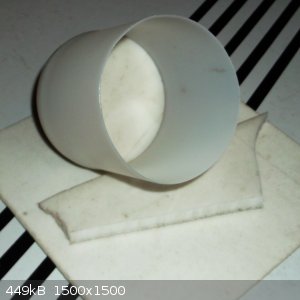 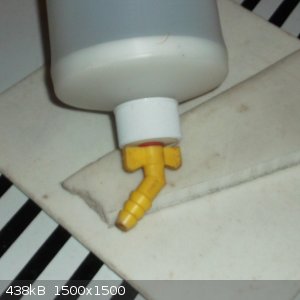 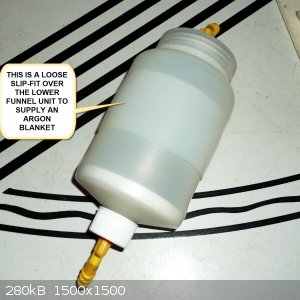
[Edited on 4-9-2014 by Dan Vizine]
|
|
|
Dan Vizine
National Hazard
   
Posts: 628
Registered: 4-4-2014
Location: Tonawanda, New York
Member Is Offline
Mood: High Resistance
|
|
There have been a number of small engineering tasks to take care of to get everything just right. This set up should provide the needed means of
suspending the reactor as well as provide the opportunity for agitation. Argon pressure will be applied to the top pipe joint.
Not too many more of these problems left now.
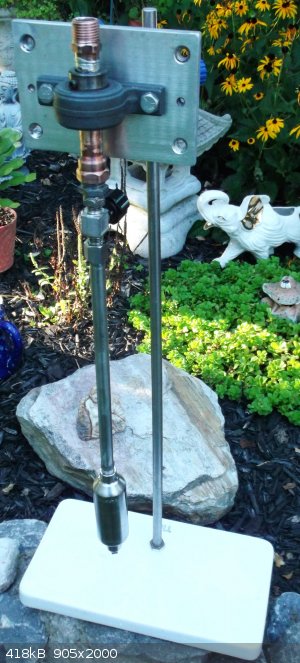
|
|
|
careysub
International Hazard
    
Posts: 1339
Registered: 4-8-2014
Location: Coastal Sage Scrub Biome
Member Is Offline
Mood: Lowest quantum state
|
|
Radiochemistry Sub-Forum
I think this thread should be moved to the new Radiochemistry sub-forum, as the techniques Dan is discussing are applicable to other actinides, and
there is a good discussion on radioactivity and exposure embedded in it.
But since this is Dan's thread, I defer to him where it should be located.
|
|
|
Pok
potassium Prometheus
  
Posts: 176
Registered: 5-12-2010
Member Is Offline
|
|
Radiochemistry is more physics - how to separate isotopes and so on. But this threat mainly deals with the chemistry of Th, not its radioactivity. The
details about exposure and so on are only side information. Rubidium and Rhenium are radioactive ass well (1/4 of Thorium). But it wouldn't make sense
to put their praparation description into the radiochemistry section.
[Edited on 12-9-2014 by Pok]
|
|
|
| Pages:
1
2
3
4
5
6
..
9 |